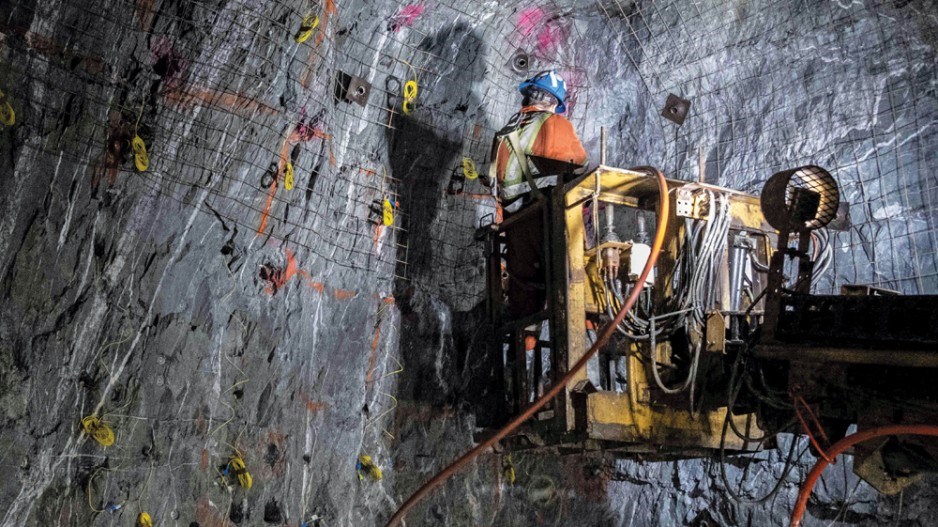Gold, jade, copper, nickel, obsidian, silver – the northwest corner of B.C., dubbed the Golden Triangle, is rich in precious and base metals.
Roughly 70 per cent of this mineral-rich region is claimed by the Tahltan First Nation as traditional territory – an area roughly the size of Portugal.
The Tahltan claimed sovereignty over their territory in a formal declaration in 1910. Though at the time its leaders expressed an interest in treaty negotiations, the Tahltan First Nation is among the few in B.C. that never entered the B.C. treaty process.
That might have become a problem for mining companies wanting to exploit the region’s mineral riches, but the Tahltan First Nation supports and is very much involved in the mining industry.
There is archaeological evidence that the Tahltan mined and traded obsidian (used for making blades, arrowheads and spearheads) as far back as 10,000 years ago, and also traded with gold miners during the gold rush of the 1800s.
There are currently two operating mines in Tahltan territory – the Red Chris copper-gold mine and the Brucejack gold mine – that provide 950 direct jobs and another 1,000 in the supply and services industry, and other projects are under development. Mining and exploration in the region has attracted an estimated $1.8 billion just in the last three years alone, according to the B.C. government.
With a workforce of skilled underground miners and numerous business interests in companies that serve the mining industry, the Tahltan are to mining what Mohawk First Nations are to ironworking.
While the Tahltan government has said no to coal bed methane extraction, and has lately been serving eviction notices to placer and jade miners over concerns about impacts to the environment and cultural sites, it otherwise generally supports and works with the mining and mineral exploration sectors. It has also worked with the provincial government on agreements to provide some certainty over land use. Thanks to its support for and involvement in mining, the First Nation has comparatively high employment levels.
“The unemployment rate for Tahltan in the area is incredibly low,” said Paul Gruner, the new CEO of the Tahltan Nation Development Corp. (TNDC). “We’re one of the largest private businesses in northwest B.C. I think that’s pretty cool, as an Indigenous business, to be a major employer and contributor to the local economy.”
Gruner is new to the TNDC. He previously was CEO of the Yellowknives Dene First Nation’s Det’on Cho Corp. He said he is impressed by the Tahltan’s business acumen and political organization.
“The Tahltan themselves are well-organized,” he said. “They’ve got political sophistication and will and desire.”
Formed in 1985 by the Tahltan Central Government, the TNDC is like a Crown corporation that operates at arm’s length and is responsible for business and economic development. It has developed numerous business ventures, including in heavy construction, earthworks, camp services, air chartering, forestry, transportation and fibre optics.
Some are owned outright by the Tahltan, while others are partnerships or joint ventures. One of the most significant of these partnerships is with Procon Mining & Tunnelling. Procon manages the underground operations at the Brucejack mine, which employs roughly 20 Tahltan miners.
Dale Day is one of them. An underground remote scoop operator, he has been a miner since 1979. Originally from Telegraph Creek, he now lives in Terrace.
Since his first job at the Erickson gold mine near Cassiar, where he got an electrical trade apprenticeship, he has worked in seven underground mines over his career. With the exception of a stint at the Cantung tungsten mine in the Yukon, all of the mines he has worked in over his career have been in northwestern B.C.
“It was actually the first time I left the Golden Triangle, when I went up to the Cantung mine,” Day said. “Other than that, all the work was pretty much in our Golden Triangle.
“The money is good,” he said. “I would love to see more Tahltans in mining. I have a big family and I always encourage them to try mining out. As far as the Tahltans and the mining go, they’ve got to coexist. Everybody depends on it up there. It’s their No. 1 industry.”
While operating mines employ some Tahltan miners, many more Tahltan are employed in service industries that are either owned by the Tahltan or operate as joint ventures. TNDC owns a fleet of heavy equipment – bulldozers, excavators, graders, loaders, dump trucks, rock trucks, packers and service and utility vehicles that have allowed the Tahltan to win a number of contracts for major projects.
In 2008, for example, TNDC secured more than $180 million in contracts with NovaGold Resources (TSX,NYSE:NG) on the Galore Creek mine project.
As for joint ventures and partnerships, one recent example is a new agreement with Sandvik AB – a Swedish multinational engineering company – making the TNCD an official reseller of mining equipment, machinery, tools and software in B.C and the Yukon.
Tahltech Drilling Services Ltd. is a partnership between TNDC and Geotech Drilling Services Ltd. that provides exploration, geotechnical, environmental, construction and other specialized drilling services.
In partnership with Northern Spirit Transportation, Tahltan NST Busing Ltd. provides a bus service that shuttles miners to and from mine camps, and through its partnership with Central Mountain Air it operates an air charter service. The TNDC also has the management contract for Dease Lake Airport.
“I think we’ve got to be the only Indigenous-controlled airport in the province right now,” Gruner said.
Tahltan businesses were also involved in the construction of the Forrest Kerr, McLymont Creek and Volcano run-of-river hydroelectric projects, and the TNDC owns five per cent of Coast Mountain Hydro, the company that owns and operates them.
Through its various business entities and partnerships, the TNDC generated $61 million in income for the 2020-21 fiscal year, held $57 million in assets and employed 360 people. The TNDC pays dividends annually to the Tahltan Central Government, and the Tahltan and Iskut band councils.


